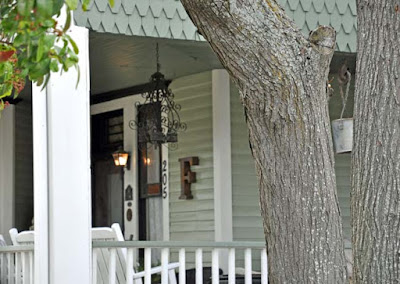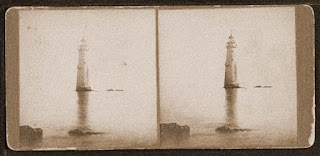There are horrifying stories of hauntings like The Devil's House and frightening possessions like the evil Raggedy Ann doll. But contrary to popular belief, not all hauntings are frightening. Take the case of the Rose of Sharon house in Waxahachie, Texas for instance.
Sharon was a realtor and was able to see beyond the weeds in the yard and the rundown condition of the long deserted house, at least enough to know that underneath all the neglect, the basic structure was sound. She realized that with a lot of work and effort, the sad house could once again be the beautiful home it once was.
The house was built in 1892 by F. P. Powell, an attorney, for his new bride and the children they hoped to have. Two daughters were born to the union and the Powell's happily lived in their Waxahachie home for 20 years. In 1912, F. P. was offered a job in Austin, one with enough of a raise and increased benefits that he couldn't turn it down and so the home they loved was sold.
Unfortunately, over the next 70 years, the house was sold a number of times and none of the owners did much in the way of taking care of it. With each successive owner, the home's condition deteriorated a little more until it was eventually abandoned.
When Sharon purchased the house, she found that it originally had wrap-around porches which provided shade and a place to sit on a porch swing to enjoy a pretty spring day, but one of the previous owners had sealed in the porches and turned the house into a number of small apartments which were rented out. The exterior walls were covered in dead vines and the walls inside were full of holes. The floors were covered with trash and creaked when they were walked on, the stairs seemed ready to fall to pieces. In short, the house was in a sad state indeed.
The day after the sale had been completed and before any restoration work had begun, Sharon took a walk around the inside. Entering a small room which at one time had been a large dining parlor, she sat her oversized handbag on the floor in the middle of the room. leaving the heavy bag, she proceeded through several more rooms until finally entering one that contained piles of old magazines and newspapers. Sitting down to thumb through the stacks, she lost track of time as she became fascinated with the news and fashions from years past.
When the shadows began to lengthen and the light to dim, she realized she had been there longer than she had intended. Hurrying back into the dining parlor to retrieve her bag, she found it right where she had left it, but sitting next to it was a pair of 14-karat gold earrings. The earrings were ones Sharon had loved and treasured, but had lost more than a year ago! She had looked everywhere for the missing jewelry, but no trace of them had turned up until now, a year after she lost them, sitting next to her handbag on the floor of a house she had not even known existed a year ago! Sharon believed then and still believes the return of her earrings had been a housewarming present from Mrs. Powell, long dead, but obviously happy Sharon had purchased her home and intended to restore it and once again fill it with love.
As the restoration work continued, Sharon would often enter a room and feel a presence of someone else. She could feel she wasn't alone, but it was never spooky and she was never frightened. Quite the contrary in fact as she said it was always a welcoming sensation.
After restoration, Sharon decided to open her now beautiful home to other people by turning it into a bed & breakfast. She doesn't advertise the ghostly presence, but some of her guests have reported hearing footsteps in the hallways at night when nobody is up and around. Sometimes footsteps are heard going up and down the stairs long after everyone has retired for the night. There are also reports of soft waltz music being heard which seems to emanate from everywhere and nowhere at the same time with no source able to be pinpointed. Most describe the sound as seeming to be stringed instruments, most likely violins. The haunting sounds are exactly what one would expect to hear coming from a cultured family home of the early 1900's.
Sharon often catches a glimpse of a family, but they are barely visible and completely disappear almost as soon as they are seen. The man wears a top hat and the woman is always wearing a long dress which appears to be from the late 1800's. There are also two children, little girls who always stand in front of their parents holding hands. They give the appearance of being very happy. Sharon thinks they are the Powell family and they seem pleased with what she has done and the way she takes care of "their" home.
The Rose of Sharon is a nice, homey bed & breakfast in the interesting town of Waxahachie, Texas. It is often full of paying guests, many of whom are repeats - folks who found the inn to be so inviting that they return multiple times. And nobody minds at all the friendly, happy ghosts that continue to watch over their home.
Sharon was a realtor and was able to see beyond the weeds in the yard and the rundown condition of the long deserted house, at least enough to know that underneath all the neglect, the basic structure was sound. She realized that with a lot of work and effort, the sad house could once again be the beautiful home it once was.
The house was built in 1892 by F. P. Powell, an attorney, for his new bride and the children they hoped to have. Two daughters were born to the union and the Powell's happily lived in their Waxahachie home for 20 years. In 1912, F. P. was offered a job in Austin, one with enough of a raise and increased benefits that he couldn't turn it down and so the home they loved was sold.
Unfortunately, over the next 70 years, the house was sold a number of times and none of the owners did much in the way of taking care of it. With each successive owner, the home's condition deteriorated a little more until it was eventually abandoned.
When Sharon purchased the house, she found that it originally had wrap-around porches which provided shade and a place to sit on a porch swing to enjoy a pretty spring day, but one of the previous owners had sealed in the porches and turned the house into a number of small apartments which were rented out. The exterior walls were covered in dead vines and the walls inside were full of holes. The floors were covered with trash and creaked when they were walked on, the stairs seemed ready to fall to pieces. In short, the house was in a sad state indeed.
The day after the sale had been completed and before any restoration work had begun, Sharon took a walk around the inside. Entering a small room which at one time had been a large dining parlor, she sat her oversized handbag on the floor in the middle of the room. leaving the heavy bag, she proceeded through several more rooms until finally entering one that contained piles of old magazines and newspapers. Sitting down to thumb through the stacks, she lost track of time as she became fascinated with the news and fashions from years past.
When the shadows began to lengthen and the light to dim, she realized she had been there longer than she had intended. Hurrying back into the dining parlor to retrieve her bag, she found it right where she had left it, but sitting next to it was a pair of 14-karat gold earrings. The earrings were ones Sharon had loved and treasured, but had lost more than a year ago! She had looked everywhere for the missing jewelry, but no trace of them had turned up until now, a year after she lost them, sitting next to her handbag on the floor of a house she had not even known existed a year ago! Sharon believed then and still believes the return of her earrings had been a housewarming present from Mrs. Powell, long dead, but obviously happy Sharon had purchased her home and intended to restore it and once again fill it with love.
As the restoration work continued, Sharon would often enter a room and feel a presence of someone else. She could feel she wasn't alone, but it was never spooky and she was never frightened. Quite the contrary in fact as she said it was always a welcoming sensation.
After restoration, Sharon decided to open her now beautiful home to other people by turning it into a bed & breakfast. She doesn't advertise the ghostly presence, but some of her guests have reported hearing footsteps in the hallways at night when nobody is up and around. Sometimes footsteps are heard going up and down the stairs long after everyone has retired for the night. There are also reports of soft waltz music being heard which seems to emanate from everywhere and nowhere at the same time with no source able to be pinpointed. Most describe the sound as seeming to be stringed instruments, most likely violins. The haunting sounds are exactly what one would expect to hear coming from a cultured family home of the early 1900's.
Sharon often catches a glimpse of a family, but they are barely visible and completely disappear almost as soon as they are seen. The man wears a top hat and the woman is always wearing a long dress which appears to be from the late 1800's. There are also two children, little girls who always stand in front of their parents holding hands. They give the appearance of being very happy. Sharon thinks they are the Powell family and they seem pleased with what she has done and the way she takes care of "their" home.
The Rose of Sharon is a nice, homey bed & breakfast in the interesting town of Waxahachie, Texas. It is often full of paying guests, many of whom are repeats - folks who found the inn to be so inviting that they return multiple times. And nobody minds at all the friendly, happy ghosts that continue to watch over their home.





